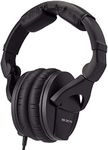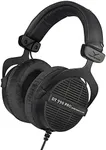Buying Guide for the Best Studio Headphones For Mixing And Mastering
Choosing the right studio headphones for mixing and mastering is crucial for achieving the best sound quality in your music production. The right pair of headphones will allow you to hear every detail in your mix, ensuring that your final product sounds great on all playback systems. When selecting studio headphones, it's important to consider several key specifications that will impact your listening experience and the accuracy of your mixes. Here are the key specs to look out for and how to choose the best fit for your needs.Frequency ResponseFrequency response refers to the range of frequencies that the headphones can reproduce, typically measured in Hertz (Hz). This spec is important because it determines how accurately the headphones can reproduce the full spectrum of sound, from the lowest bass to the highest treble. A wider frequency response range (e.g., 20 Hz to 20 kHz) is generally better, as it ensures that you can hear all the details in your mix. If you work with genres that have a lot of low-end or high-end content, make sure the headphones can handle those frequencies well.
ImpedanceImpedance is a measure of electrical resistance and is measured in ohms (Ω). It affects how much power is required to drive the headphones. Low impedance headphones (below 50 ohms) are easier to drive and can be used with portable devices like smartphones and laptops. High impedance headphones (above 50 ohms) usually require a dedicated headphone amplifier to reach their full potential. For studio use, higher impedance headphones are often preferred because they can provide better sound quality and more accurate reproduction, but make sure you have the necessary equipment to drive them properly.
Driver SizeThe driver is the component inside the headphones that converts electrical signals into sound. Driver size is typically measured in millimeters (mm). Larger drivers (e.g., 40mm or more) can move more air and generally produce better bass response and overall sound quality. However, driver size is not the only factor that determines sound quality, as the design and materials used also play a significant role. If you prioritize strong bass and clear sound, look for headphones with larger drivers, but also consider the overall build quality.
Open-Back vs. Closed-BackOpen-back headphones have ear cups that allow air and sound to pass through, providing a more natural and spacious sound. They are great for mixing because they offer a more accurate representation of the stereo field. However, they leak sound and are not suitable for recording in noisy environments. Closed-back headphones have sealed ear cups that isolate sound, making them better for recording as they prevent sound leakage and block external noise. For mixing and mastering, open-back headphones are generally preferred, but if you need to record in the same space, closed-back headphones might be more practical.
Comfort and Build QualityComfort and build quality are important because you will likely be wearing your headphones for extended periods. Look for headphones with adjustable headbands, cushioned ear pads, and lightweight designs to ensure comfort during long mixing sessions. Durable materials and solid construction are also important to ensure that your headphones can withstand regular use. Try to find a balance between comfort and durability, and consider how the headphones feel during extended wear.
Sound IsolationSound isolation refers to the headphones' ability to block out external noise. This is particularly important if you are working in a noisy environment or need to focus on the details of your mix without distractions. Closed-back headphones typically offer better sound isolation than open-back headphones. If you need to work in a quiet space or need to avoid disturbing others, prioritize headphones with good sound isolation. However, if you are in a controlled studio environment, this may be less of a concern.
















